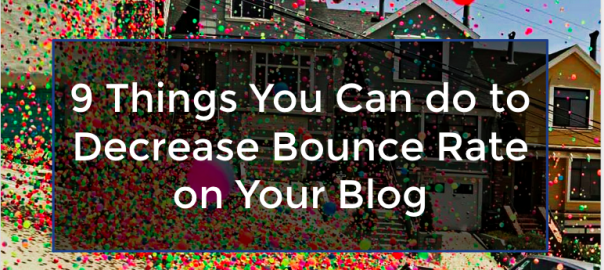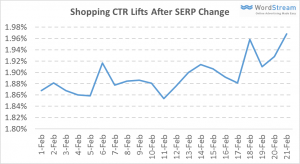
As a fellow blogger you’ve probably noticed that no matter how engaging you think you are, most of your traffic is going to bounce as soon as (if not before) they’ve read the headline.
Now, you can think “they’re a lost cause, anyway!” or you can take a good long look at what might be preventing them from staying on your article and doing a little browsing.
I’m going to share with you what the Wishpond blog does to decrease bounce rates and how you can do the same.
1. “I’m going to start off by telling you a story”
You got excited there, didn’t you? If I click on a link and am brought to an article that begins with a story, even a short one, I’m not only way more likely to continue reading but also to check out similar articles. Funny that, people like stories.
The only thing I want to say about this is, don’t push it. If it’s not flowing, don’t force it. I can’t tell you the number of times I’ve started reading something and thought “I don’t know who this was more painful for, the writer or me having to read it.”
If you’re sitting there unable to think of a relatable story, don’t push it because everybody else is. It’s going to sound like a weak stretch for you to regale me with wild analogy or anecdote that doesn’t relate to the subject at hand.
The idea behind a story is to help relate people to the subject they’re reading. It creates context, provides meaning, and develops your relationship with your readers (Hi guys!!)
If you tell me that Google Analytics is like a cup of coffee, I’m going to think you’re a weirdo.
2. Show off your personality
Not only do I enjoy writing more when I get to give off a little bit of Samantha Mykyte (that’s me!) but I think you’re a lot more entertained as a reader. I also can’t count the number of times I’ve laughed today (at myself) between writing status updates, other articles, and emails.
Equally, I’m way more likely to read something if it is able to take something boring and give it a little quirk. For you it might translate a little differently. Test your blogging persona or and see what works for you.
3. Reveal your business’ metrics
Now, not everyone can do this. As a small business just starting out you can’t entice people to start working with you if you say, “Hey guys check out how terrible our numbers are.”
I’m sure if you’re in online marketing you’ve heard of Buffer. How they released their salaries, and show their revenue publically on a live dashboard. Well, it’s easy to be transparent when you’re revealing only good things.
The thing is, if you’re not quite ready to reveal those big numbers, start small (with a successful marketing strategy, for instance) to test the waters.
Answer those questions people are just dying to get insight on, such as:
- What are the open and click-through rates on your emails? Imagine this reveal like a mini-case study of your own business: You’re saying, this is what happened when we did A, B and C.
- What is the engagement rate on your social media accounts? Share the numbers behind the posts that have done well as well as those that haven’t. It’s super easy to get the analytics behind your most (and least) successful posts.
- How much money do you spend money on advertising? Share a breakdown of the different amounts of money you spend to get your business in front of the right target audience. This kind of reveal is very powerful at creating conversations.
4. Teach something that you’ve learned through doing
This sounds like it’s piggybacking on the previous section, but it’s not. You’re sharing more than the numbers, you’re sharing how you got there.
This strategy can be a bit of a balancing game between being good and being honest. If you simply go out there and share all of your great, no-fail plans you’re going to come across as yes, being great, but not particularly honest (and won’t create the friendly relationship you want).
Essentially your goal is to share your success and how you got there but also share how you’ve grown from failure.
How can you do it?
Share some of the strategies you’ve used to grow your business. For example what happened when you stopped using ads? Changed your prices? Started blogging? Switched social platforms? All of these are common things that other businesses are likely to face at some point in their evolution. Help other people through this by being upfront and honest about what they might expect.
5. Create an engaging persona through a video and author’s bio
People want to engage with people. By adding a video to the top of your articles (you probably watched the one attached to this article) it will encourage people to engage with you as the author.
Give readers a one-two punch by creating an amazing author bio for the bottom of your page as well as video at the top (or halfway down). They’ll see your beautiful smile, shining back at them, and, a write-up about who you are as an individual.You can use your bio as a chance to include some more of your wonderful personality, links to some of your most popular articles or your social media accounts.
How these strategies reduce your blog’s bounce rate
- When you make a real connection with people they’re way more likely to stay on the page, finish your article, and look for more like it. Putting a face to the name is going to get them interested in opening your emails, subscribing to your blog and looking for more of you (so long as your content is smiley as well as your face).
- If you’re willing to give a little of yourself to your reader, they’re going to be a lot more willing to give up themselves. If someone is on your article and it’s clear that a ton of thought (this sometimes means more work) has gone into it they’re going to be way more likely to come back for more.
6. Share a list of ‘Top articles’ or Ebooks on a given category
You’re in charge of which articles fall into your “top articles” category. This could be based on traffic, engagement, or random ones you want people to start looking at. Maybe they’re the newest ones and you want to drive traffic to them. Maybe they’re simply your favorite. Or maybe they’re the ones you’ve proven generate the most upgrades for your products.
Here’s an example of what it looks like on the Wishpond blog. We have it placed in the sidebar of desktop (if you’re reading this on mobile, we’ve shifted it to make the blog mobile responsive, sorry!):

7. Get people to subscribe to your blog
When you get people interested in subscribing to your blog you’ll be able to email them with updates about other articles. I know, I know, this doesn’t technically reduce bounced traffic on the first article they’re on but what it will do is increase the likelihood of someone staying on your article in the future.
This is because the people who open your email and are given the title of the articles will only click on that article if they’re super interested.

8. Share related articles at the bottom of your article
Chances are, your article isn’t going to be more than 1500 words. In this amount of time it’s unlikely you’ll be able to share all of the things you want to. It’s just not possible.
So here’s what I recommend: At the bottom of each of your articles, share content related to the subject at hand. This will keep people on your blog longer and keep them reading more of your awesomeness.
The following example is from this article: 20-Point Retargeting (Remarketing) Ad Checklist

Did I get you to click the link above? The “20-Point Retargeting (Remarketing) Ad Checklist?”
This takes me to my next point…
9. Link to related articles within the article itself
In addition to having related articles at the bottom it’s a good idea to also share links to related content you’re sharing at the moment it happens.
Something like this…

How these strategies reduce your blog’s bounce rate:
- How many times have you gotten halfway through an article but then gotten bored or distracted? Well, maybe they were bored by this article but another one in the sidebar caught their eye. With the tactics above, instead of bouncing your readers are now checking out something that is more pertinent to them.
- Also, they might not know you’ve written on similar topics. When you link to your other articles you’re establishing yourself as a credible resource.
Conclusion
Isn’t the main point of writing an article to get someone interested enough to complete another action? And by another action I mean: following you on social media, converting on another offer or simply reading another article etc.
The point I’m trying to make here is that you’re not trying to write to a disengaged audience. You’re writing for a reason. Whatever that reason is, is totally up to you. But hopefully there’s some gold in this article to help keep people reading and not hitting the back button.
What do you do to decrease bounce rates? Comment below.
Written by Samantha Mykyte
(254)





